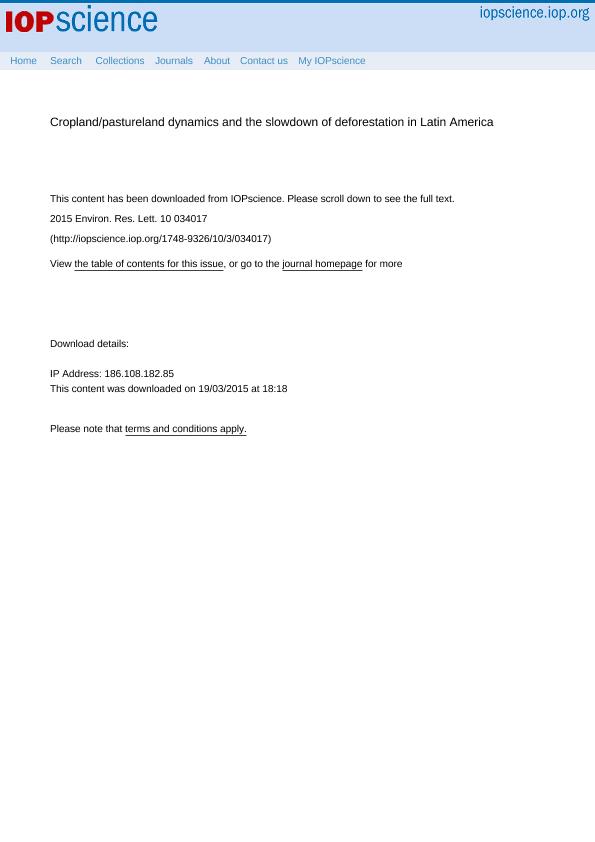Mostrar el registro sencillo del ítem
dc.contributor.author
Grasser, J
dc.contributor.author
Aide, T. M-
dc.contributor.author
Grau, Hector Ricardo

dc.contributor.author
Ramankutty, N
dc.date.available
2019-05-28T18:53:07Z
dc.date.issued
2015-04
dc.identifier.citation
Grasser, J; Aide, T. M-; Grau, Hector Ricardo; Ramankutty, N; Cropland / pastureland dynamics and the slowdown of deforestation in Latin America; IOP Publishing; Environmental Research Letters; 10; 3; 4-2015
dc.identifier.issn
1748-9326
dc.identifier.uri
http://hdl.handle.net/11336/77339
dc.description.abstract
Latin America has the planet?s largest land reserves for agriculture and had the most rapid agriculturalexpansion during the twenty-first century. A large portion of the expansion replaced forests, as shownby many local and regional studies. However, expansion varied regionally and also replaced other landcovers. Further, it is important to distinguish between changes in cropland and pastureland as theyproduce food at different levels of efficiency and intensity.Weused thirteen years (2001?2013) ofMODerate Resolution Imaging Spectroradiometer satellite imagery to characterize cropland andpastureland expansion at multiple scales across Latin America. From 2001 to 2013, 17% of newcropland and 57% of new pastureland replaced forests throughout Latin America. Croplandexpansion from 2001 to 2013 was less (44.27 Mha) than pastureland (96.9 Mha), but 44% of the 2013cropland total was new cropland, versus 27% of the 2013 pastureland total, revealing higher regionalexpansion rates of row crop agriculture. The majority of cropland expansion was into pasturelandwithin core agricultural regions of Argentina, Brazil, Bolivia, Paraguay, and Uruguay. Onthe contrary,pastureland largely expanded at frontiers, such as central Brazil, western Paraguay, and northernGuatemala. As others have suggested, regional agriculture is strongly influenced by globalization.Indeed, we find an overall decrease in agricultural expansion after 2007, coinciding with the globaleconomic slowdown. The results illustrate agricultural cropland and pastureland expansion acrossLatin America is largely segregated, and emphasize the importance of distinguishing between the twoagricultural systems, as they vary in land use intensity and efficiency.
dc.format
application/pdf
dc.language.iso
eng
dc.publisher
IOP Publishing

dc.rights
info:eu-repo/semantics/openAccess
dc.rights.uri
https://creativecommons.org/licenses/by-nc-sa/2.5/ar/
dc.subject
Land Use Change
dc.subject
Gasslands
dc.subject
Pasturelands
dc.subject
Latin America
dc.subject.classification
Meteorología y Ciencias Atmosféricas

dc.subject.classification
Ciencias de la Tierra y relacionadas con el Medio Ambiente

dc.subject.classification
CIENCIAS NATURALES Y EXACTAS

dc.title
Cropland / pastureland dynamics and the slowdown of deforestation in Latin America
dc.type
info:eu-repo/semantics/article
dc.type
info:ar-repo/semantics/artículo
dc.type
info:eu-repo/semantics/publishedVersion
dc.date.updated
2019-05-23T19:09:36Z
dc.journal.volume
10
dc.journal.number
3
dc.journal.pais
Reino Unido

dc.journal.ciudad
Londres
dc.description.fil
Fil: Grasser, J. McGill University; Canadá
dc.description.fil
Fil: Aide, T. M-. Universidad de Puerto Rico; Puerto Rico
dc.description.fil
Fil: Grau, Hector Ricardo. Universidad Nacional de Tucumán. Instituto de Ecología Regional. Consejo Nacional de Investigaciones Científicas y Técnicas. Centro Científico Tecnológico Conicet - Tucumán. Instituto de Ecología Regional; Argentina
dc.description.fil
Fil: Ramankutty, N. McGill University; Canadá
dc.journal.title
Environmental Research Letters

dc.relation.alternativeid
info:eu-repo/semantics/altIdentifier/url/https://iopscience.iop.org/article/10.1088/1748-9326/10/3/034017/pdf
dc.relation.alternativeid
info:eu-repo/semantics/altIdentifier/doi/http://dx.doi.org/10.1088/1748-9326/10/3/034017
Archivos asociados
